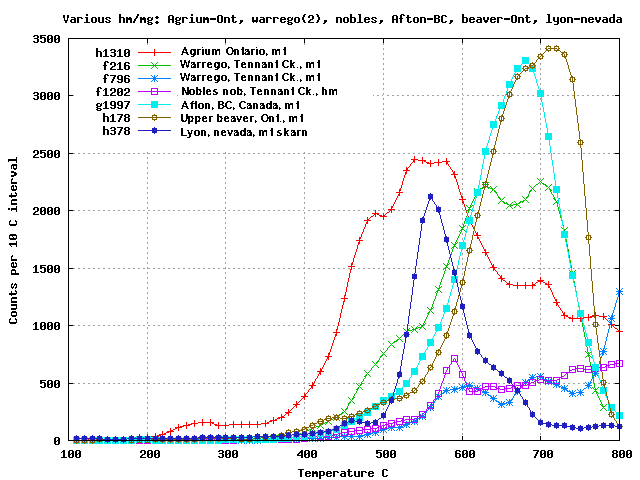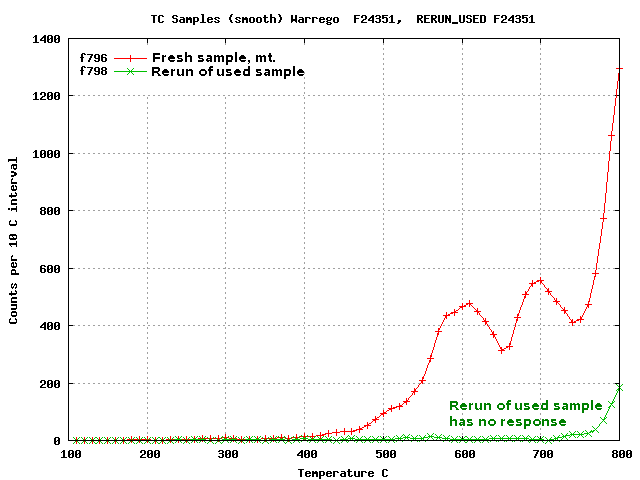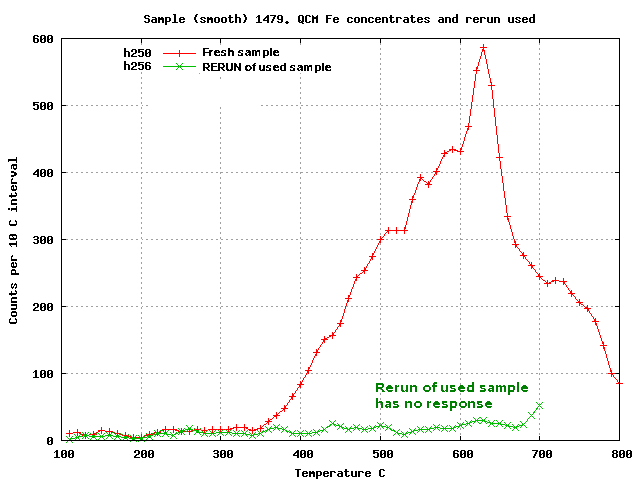Haematite and magnetite are important
host or accessory minerals in many mineral deposits, particularly the
"Iron-oxide, copper, gold" type of deposits and many skarn deposits. In
many of these deposits quartz is absent, rare or a late stage overprint
and not related to the mineralisation event. To understand the fluid
conditions during deposition of these deposits it is necessary to study
opaque minerals and the normal fluid inclusion methods cannot be used.
Although we cannot see fluid inclusions in haematite and magnetite,
they most certainly do exist and the baro-acoustic decrepitation method
can be used to study the fluids in these opaque minerals. In many
provinces there are stratigraphic iron oxide units co-existing with
other
valuable mineral deposits, which has led to major controversy in
deciding if the deposits are of sedimentary or hydrothermal origin. The
information from the fluid inclusions in the opaque minerals is crucial
to determine the precise origin of these deposits
and to resolve the controversies.
Baro acoustic decrepitation of some haematite and magnetite minerals
from typical iron oxide deposits show
intense decrepitation. This occurs in both magnetite and haematite. If,
as some researchers have claimed, haematite is merely a supergene
oxidation of primary magnetite, then this would have destroyed any
fluid inclusions present. The observation of decrepitation in
haematite shows that it is often a primary mineral and not merely a
supergene alteration product.

The Agrium mine in Ontario is a magnetite bearing carbonatite, being
mined for phosphate.
The Warrego mine in Tennant Creek, NT., was a major producer of Cu and
Au from a magnetite and chlorite host rock which was quartz deficient.
The Nobles Nob mine in Tennant Creek, NT., was a major Au
producer from haematite host rocks, and is now closed. The Afton mine,
near Kamloops in British
Columbia, has produced Cu and Au and is now closed. The Upper
Beaver deposit in Ontario was mined for Au, hosted in massive
magnetite. The Lyon skarn deposit in Nevada, USA, was prospected as a
potential Fe and Cu source. In almost all of these deposits quartz is
not available to study the mineralising fluid system and the use of
haematite and magnetite is the only way to understand the fluid
processes which caused the mineralisation.
Decrepitation in haematite and magnetite usually continues up to the
instrumental maximum temperature of 800 C, in contrast to quartz in
which decrepitation is negligible above the alpha-beta transition
temperature of 573 C. The decrepitation patterns are often quite
complex and the results are compared with other nearby samples to map
out variations in the decrepitation behaviour across an exploration
area. In quartz, low temperature decrepitation peaks are caused
by CO
2 rich fluids,
as explained here.
Based on the same thermodynamics, this effect should also occur in
haematite and magnetite, but such low temperature peaks are rarely
observed. Perhaps this is because hydrothermal haematite and magnetite
usually
deposit from CO
2 poor fluids.
The decrepitation events observed in haematite and magnetite are not
caused by mechanical or crystallographic effects, and are the result of
explosive decompression accompanying fluid release from inclusions. The
instrument only detects pressure waves generated by such decompression
and cannot detect the shear waves generated by crystallographic
transitions as shear waves cannot travel to the sensor
through the intervening fluid medium (air) in the apparatus,
as explained here.
Additional confirmation is provided by the fact that re-analysing a
sample that has already been analysed, gives no decrepitation counts.
The cause of the decrepitation counts must be an irreversible process,
such as inclusion fracture and decompression and cannot be due to any
reversible process such as phase transitions in a crystalline mineral
or mechanical effects in the apparatus. Two samples have been
reanalysed in this manner and demonstrate the absence of decrepitation
when the same sample aliquot is re-analysed.

Another test of reanalysing a previously analysed aliquot used steel
mill concentrartes from Quebec.

Summary
Fluid inclusions in haematite and
magnetite can be used to help understand the fluid conditions during
mineral deposition. Just because the mineral is opaque does not mean we
should ignore the valuable information which can be ascertained by
studying fluid inclusions. Although it is more difficult to work with
opaque minerals, it is not impossible. Additional studies have been
done using decrepitation in pyrite. There are also other methods which
can be used on fluid inclusions in opaques, such
as gas analyses by
mass spectrometer during thermal decrepitation in a vacuum and
observation using infrared light.
Several studies of haematite / magnetite mineralised systems have been
carried out including the Great Bear
magmatic zone, Canada and at
Tennant Creek, NT, Australia. And
there is an overview of many other
haematite and magnetite studies here.
 Applied Mineral Exploration
Applied Mineral Exploration Discussion and research relevant to mineral
exploration.
Discussion and research relevant to mineral
exploration. 

